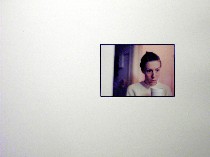 That’s enough on Slought. I feel as if our coverage of the show was somewhat unbalanced because all the writers went as a class, so the same pieces got attention over and over. So here’s my final sally at it and then no more, because the show, while it offers a bunch of artists who are not the usual suspects, is not worth this much space.
That’s enough on Slought. I feel as if our coverage of the show was somewhat unbalanced because all the writers went as a class, so the same pieces got attention over and over. So here’s my final sally at it and then no more, because the show, while it offers a bunch of artists who are not the usual suspects, is not worth this much space.
I just want to point out that my friend Ditta Baron Hoeber’s wonderful book, “Movie,” hasn’t been mentioned (I mean the “wonderful,” and not because she’s my buddy). It takes some white gloves and a little bit of time to browse its pristine pages, but there are several things I really love about this piece:
One is how it is a story within a story, a photographic tale of Hoeber’s son, Julian, who is an art luminary in his own right, making a movie. The shots are unexpected, deliberately off-kilter images that focus on surprising juxtapositions of people and the claustrophobic room in which they are working.
The other thing is the extreme preciousness of the presentation with enormous white mattes framing the small, oddly framed shots, a somewhat ironic commentary on the contents and the pop-culture phenomenon of movie-making and its seat-of-the-pants process. The small size of the photos is also a commentary on the large size of the movie screen and how it absorbs our lives and vision.
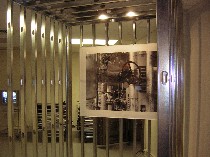 In the modest location of the book on a shelf, with its modest size, it sits in intense contrast to a gigantic, photographic installation also about framing, by Intellectual Property, “Frames of Referents.” The piece shows a construction site–or maybe it’s a large building’s infrastructure–and sites it within a framework that suggests framed-out walls. Then there’s a plaque on the wall that allows words to further frame it. But I don’t find what’s being framed a really interesting commentary on the world in which we live, or on art.
In the modest location of the book on a shelf, with its modest size, it sits in intense contrast to a gigantic, photographic installation also about framing, by Intellectual Property, “Frames of Referents.” The piece shows a construction site–or maybe it’s a large building’s infrastructure–and sites it within a framework that suggests framed-out walls. Then there’s a plaque on the wall that allows words to further frame it. But I don’t find what’s being framed a really interesting commentary on the world in which we live, or on art.
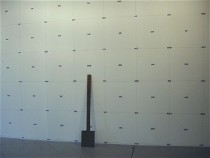 I also want to mention that Lydia Hunn’s “Shit/Snow/Sand,” which we reviewed in the Shovel Show at Highwire Gallery, has a more compressed installation here at Slought that doesn’t do the piece service.
I also want to mention that Lydia Hunn’s “Shit/Snow/Sand,” which we reviewed in the Shovel Show at Highwire Gallery, has a more compressed installation here at Slought that doesn’t do the piece service.
I am mentioning both Hoeber and Hunn because I think the reviews ended up gulaging them because they weren’t newcomers to the Philadelphia scene.
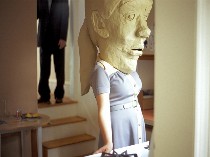 Another artist I feel has been overlooked who I’d like to mention in the show is Michelle Posadas, for her photos of scenarios in which the people wear giant papier mache masks that reveal everyday people and their lives as deeply weird.
Another artist I feel has been overlooked who I’d like to mention in the show is Michelle Posadas, for her photos of scenarios in which the people wear giant papier mache masks that reveal everyday people and their lives as deeply weird.
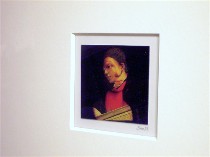 And finally, Ruth Shenkman’s tiny collaged images have a how-did-she-do-this finesse. Like Hoeber, Shenkman uses the giant matte to focus in on the smallness of her work.
And finally, Ruth Shenkman’s tiny collaged images have a how-did-she-do-this finesse. Like Hoeber, Shenkman uses the giant matte to focus in on the smallness of her work.
Others in the show include Keiko Miyamori with a typewriter meets nature piece, Michael Barker with a neon Bruce Naumann ripoff, David Webber with a sound/mechanical piece, Beth Blinebury with body-issue photos, Diane Liason with amber-coated books, Mary Kate Maher with an installation about infrastructure, Lucy Russo with photo collage, Alicia Keller with a stretched string piece that doesn’t bring to mind Fred Sandback, Jeff Meyers with a what-is-it sculpture, Morgan Craig’s painting of a complex, architectural strange space.
What I liked best about this show was its departure from the usual suspects.









